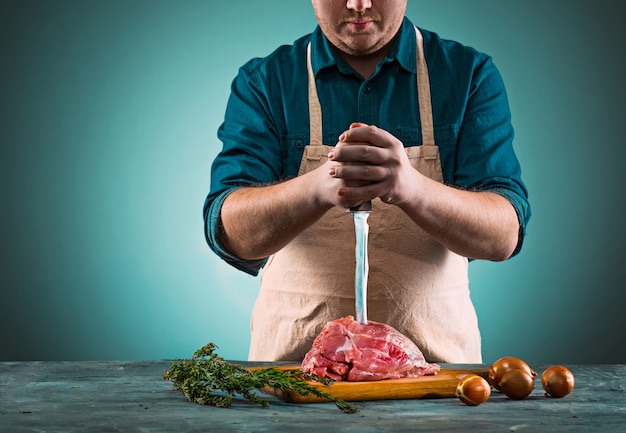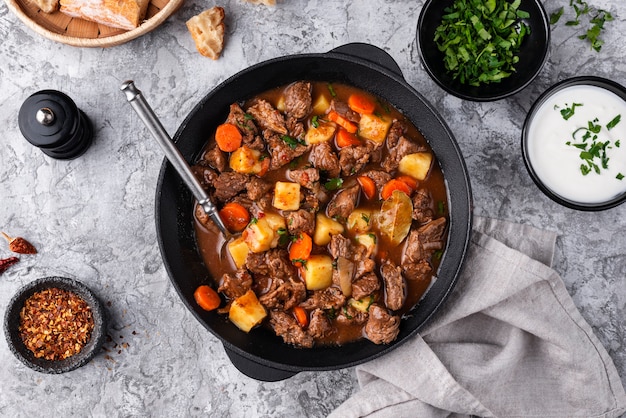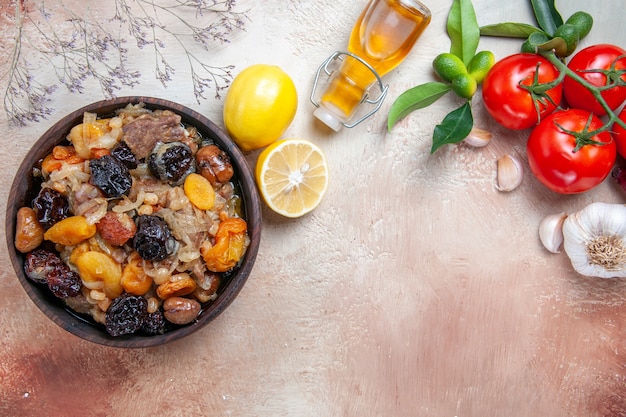(Part 1) Choosing the Right Cut

The first step to cooking a delicious lamb dish is choosing the right cut of meat. There are so many different options available, each with its own unique flavour and texture. Knowing what you’re looking for can really make a difference in the final outcome of your meal.
What to Look for
When you’re at the butcher’s, keep an eye out for cuts of lamb that have a good amount of marbling. Marbling refers to the streaks of fat throughout the meat, and it’s essential for a juicy and flavorful dish. The fat melts during cooking, basting the meat and adding a rich, savory flavour. You can also ask your butcher for advice on which cuts would be best for your intended dish. They're experts and can guide you towards the perfect cut for your needs.
Here are some of the most common cuts of lamb and their best uses:
- Shoulder: A great choice for roasts, stews, and curries. It’s a tougher cut, but it becomes incredibly tender and flavourful with long, slow cooking methods. Think of slow braising or a rich, hearty lamb curry.
- Leg: This is a versatile cut, perfect for roasting, grilling, or braising. It’s also great for making lamb chops. Whether you prefer a classic roast lamb or a more robust grilled option, the leg is a good choice.
- Rack: These bone-in cuts are fantastic for grilling or roasting. The bone adds flavour to the meat, and the ribs provide a stunning visual presentation. Think of a rack of lamb for a special occasion dinner.
- Loin: The loin is a tender and flavorful cut, perfect for grilling or pan-frying. It’s often sold as lamb chops. It's a classic choice for a quick and easy meal.
- Breast: This is a less common cut, but it’s perfect for making a tender and flavourful lamb stew. Think of a rustic stew that's full of flavour.
(Part 2) cooking techniques

Now that you’ve got your perfect cut of lamb, it’s time to dive into the different cooking methods you can use to bring out the best in your meat.
- Roasting: Roasting is a classic way to cook lamb. It’s a simple method that yields a tender and flavorful result. The key to roasting lamb is to cook it at a low temperature for a longer period. This allows the meat to cook evenly and develop a beautiful crust. Think of a Sunday roast with all the trimmings.
- Grilling: Grilling lamb is a quick and easy way to cook it. The intense heat of the grill creates a delicious char on the outside and juicy, tender meat on the inside. It’s a fantastic way to enjoy lamb chops or lamb skewers. Think of a summer barbecue with friends.
- Pan-frying: Pan-frying is perfect for cooking smaller cuts of lamb, like lamb chops or lamb steaks. It’s a quick and easy method that allows you to achieve a beautiful crust and a tender, juicy interior. Think of a quick and easy meal during the week.
- Braising: Braising is a great way to cook tougher cuts of lamb, like shoulder or shank. It involves browning the meat in a pan, then simmering it in a flavorful liquid until it’s tender. Think of a slow-cooked, melt-in-your-mouth dish.
- Stewing: Stewing is similar to braising, but it involves cooking the lamb in a liquid for a longer period of time. It’s a great way to create a hearty and flavorful stew. Think of a comforting dish on a cold day.
(Part 3) Lamb cooking tips

Now that you know the basics of choosing the right cut and different cooking methods, let’s talk about some tips that will take your lamb cooking to the next level.
- Seasoning: Don’t be afraid to experiment with different seasonings. Lamb pairs beautifully with herbs like rosemary, thyme, garlic, and oregano. You can also add a pinch of cumin, coriander, or paprika for a more exotic flavour. Don't be afraid to get creative!
- Resting: Once your lamb is cooked, let it rest for at least 10 minutes before carving. This allows the juices to redistribute throughout the meat, resulting in a more tender and flavorful dish. This is a crucial step that's often overlooked.
- Doneness: Lamb can be cooked to various levels of doneness, from rare to well-done. Use a meat thermometer to ensure that your lamb is cooked to your liking. It's important to cook lamb to the right temperature for food safety and enjoyment.
- Basting: Basting your lamb during cooking helps to keep it moist and tender. You can use a mixture of butter, oil, and herbs to baste your lamb. This is a simple trick that makes a big difference in the final result.
- Serving: Lamb can be served with a variety of sides, including roasted vegetables, potatoes, rice, couscous, and salads. The possibilities are endless!
(Part 4) lamb roast: A Classic Recipe
Okay, let’s jump into a classic recipe that I love to make. This roast lamb recipe is foolproof and always impresses. It’s a great option for a special occasion or a family gathering.
Ingredients:
- 1 (5-7 pounds) boneless leg of lamb
- 2 tablespoons olive oil
- 1 tablespoon salt
- 1 teaspoon black pepper
- 1 teaspoon garlic powder
- 1 teaspoon onion powder
- 1 teaspoon dried rosemary
- 1 teaspoon dried thyme
Instructions:
- Preheat your oven to 325°F (160°C).
- In a small bowl, combine the olive oil, salt, pepper, garlic powder, onion powder, rosemary, and thyme.
- Rub the spice mixture all over the leg of lamb.
- Place the lamb in a roasting pan and roast for 1 1/2 to 2 hours, or until a meat thermometer inserted into the thickest part of the lamb registers 145°F (63°C) for medium-rare.
- Let the lamb rest for 10 minutes before carving.
This recipe is so easy and versatile. You can use different herbs and spices to create your own unique flavour profile. I often add a tablespoon of honey to the spice mixture for a hint of sweetness. You can also experiment with different roasting techniques, such as using a low and slow method for extra tenderness.
(Part 5) Lamb Chops: A Quick and easy recipe
Let’s talk about lamb chops. They’re a real crowd-pleaser and a great choice for a weeknight meal. You can have them on the table in no time with this quick and easy recipe.
Ingredients:
- 8 lamb chops
- 1 tablespoon olive oil
- 1 teaspoon salt
- 1/2 teaspoon black pepper
- 1/4 teaspoon garlic powder
- 1/4 teaspoon onion powder
- 1 tablespoon chopped fresh rosemary
Instructions:
- Preheat your grill or pan to medium-high heat.
- In a small bowl, combine the olive oil, salt, pepper, garlic powder, onion powder, and rosemary.
- Rub the spice mixture all over the lamb chops.
- Grill or pan-fry the lamb chops for 3-4 minutes per side, or until they reach your desired level of doneness.
- Let the lamb chops rest for 5 minutes before serving.
These lamb chops are delicious served with a simple side of roasted vegetables or a salad. If you’re feeling adventurous, try adding a squeeze of lemon juice or a dollop of Dijon mustard before serving. You can also make a simple pan sauce by deglazing the pan with a little red wine or stock and adding a knob of butter.
(Part 6) Lamb Curry: An Exotic Recipe
Now, let’s head to the world of Indian cuisine with a delicious lamb curry. This recipe is rich, aromatic, and so flavorful. It’s perfect for a chilly evening.
Ingredients:
- 1 pound lamb, cubed
- 1 tablespoon olive oil
- 1 onion, chopped
- 2 cloves garlic, minced
- 1 inch ginger, grated
- 1 teaspoon ground cumin
- 1 teaspoon ground coriander
- 1/2 teaspoon turmeric
- 1/4 teaspoon cayenne pepper (optional)
- 1 (14 ounce) can diced tomatoes, undrained
- 1 cup chicken broth
- 1/2 cup heavy cream
- Salt and pepper to taste
- Chopped cilantro for garnish
Instructions:
- In a large pot or dutch oven, heat the olive oil over medium heat.
- Add the lamb and cook, stirring occasionally, until browned on all sides.
- Add the onion, garlic, and ginger to the pot and cook, stirring frequently, until the onion is softened, about 5 minutes.
- Stir in the cumin, coriander, turmeric, and cayenne pepper (if using). Cook for 1 minute, stirring constantly.
- Add the diced tomatoes, chicken broth, and heavy cream to the pot. Bring to a boil, then reduce heat to low, cover, and simmer for 1 1/2 to 2 hours, or until the lamb is tender.
- Season with salt and pepper to taste.
- Garnish with chopped cilantro and serve with rice or naan bread.
This lamb curry is absolutely bursting with flavour. The combination of spices creates a truly unique and delicious dish. You can adjust the spice level to your liking by adding more or less cayenne pepper. For a deeper flavour, try making your own curry paste by blending together the spices with a little oil and garlic.
(Part 7) Lamb and Mint Sauce: A Classic Pairing
Now, no lamb dish is complete without a good sauce. And for me, there’s nothing that goes better with lamb than a classic mint sauce. It's a simple sauce that brings a freshness and brightness to any lamb dish. It's the perfect accompaniment to roasts, grilled lamb, or even a simple lamb stew.
Ingredients:
- 1 cup fresh mint leaves
- 1/2 cup white wine vinegar
- 1/4 cup water
- 1/4 cup sugar
- Salt to taste
Instructions:
- Combine all the ingredients in a blender or food processor and blend until smooth.
- Strain the sauce through a fine-mesh sieve to remove any large pieces of mint.
- Serve the sauce chilled or at room temperature.
This mint sauce is so easy to make and keeps well in the fridge for a few days. You can also add a pinch of sugar or a splash of lemon juice to adjust the sweetness and acidity to your liking. For a more intense mint flavour, try using a combination of fresh and dried mint.
(Part 8) Lamb cooking faqs
Now let’s tackle some of those questions you might have about lamb cooking.
- How do I know when lamb is cooked? The best way to tell if lamb is cooked is to use a meat thermometer. Lamb is safe to eat when it reaches an internal temperature of 145°F (63°C) for medium-rare. If you're unsure, it's always better to err on the side of caution and cook it a little longer.
- What’s the best way to store lamb? Fresh lamb should be stored in the refrigerator for up to 3 days. You can also freeze lamb for up to 3 months. Be sure to wrap it tightly to prevent freezer burn.
- Can I cook lamb from frozen? It's not recommended to cook lamb from frozen. Frozen lamb takes longer to cook and can be more difficult to get a consistent level of doneness. It's best to thaw it in the refrigerator overnight before cooking.
- How can I make sure my lamb is tender? Slow cooking is a great way to tenderize lamb. Braising or stewing lamb in a flavorful liquid for a longer period will break down the tough fibers and make it super tender. Consider using a slow cooker or a Dutch oven for this purpose.
- What are some creative ways to use leftover lamb? Leftover lamb is perfect for sandwiches, salads, or pasta dishes. You can also use it to make a delicious shepherd’s pie or a hearty lamb soup. Leftover lamb is a great way to create new meals without wasting food.
(Part 9) Conclusion
So there you have it! A complete guide to lamb cooking, from choosing the right cut to mastering different techniques, and a few of my favorite recipes thrown in for good measure. Remember, the key to delicious lamb is to choose a good cut of meat, season it generously, and cook it to your liking. Don’t be afraid to experiment with different flavours and spices. You can create some amazing dishes that will impress your friends and family.
Now, go forth and conquer the world of lamb cooking!
(Part 10) A Table for Visual Reference
To help you visualize the different cuts of lamb and their best uses, I've created this table:
| Cut | Best Uses |
|---|---|
| Shoulder | Roasts, stews, curries |
| Leg | Roasts, grilling, braising, lamb chops |
| Rack | Grilling, roasting |
| Loin | Grilling, pan-frying, lamb chops |
| Breast | Stews |
This table can be a helpful guide when you're at the butcher's or planning your next lamb dish.
Everyone is watching

Perfect Rice Every Time: The Ultimate Guide to Cooking Rice
Cooking TipsAs a self-proclaimed foodie, I've always been a bit obsessed with rice. It's the foundation of countless cuisi...

Prime Rib Roast Cooking Time Chart: Per Pound Guide
Cooking TipsPrime rib roast. Just the name conjures images of lavish dinners, crackling fires, and hearty laughter. It’s ...

The Ultimate Guide to Cooking Asparagus: Tips, Techniques, and Recipes
Cooking TipsAsparagus. The mere mention of this spring delicacy conjures up images of vibrant green spears, crisp and burs...

Ultimate Guide to Cooking the Perfect Thanksgiving Turkey
Cooking TipsThanksgiving. Just the word conjures up images of overflowing tables laden with delicious food, the scent of r...

How Long to Bake Potatoes in the Oven (Perfect Every Time)
Cooking TipsBaked potatoes are a staple in my kitchen. They're incredibly versatile, delicious, and surprisingly easy to m...
